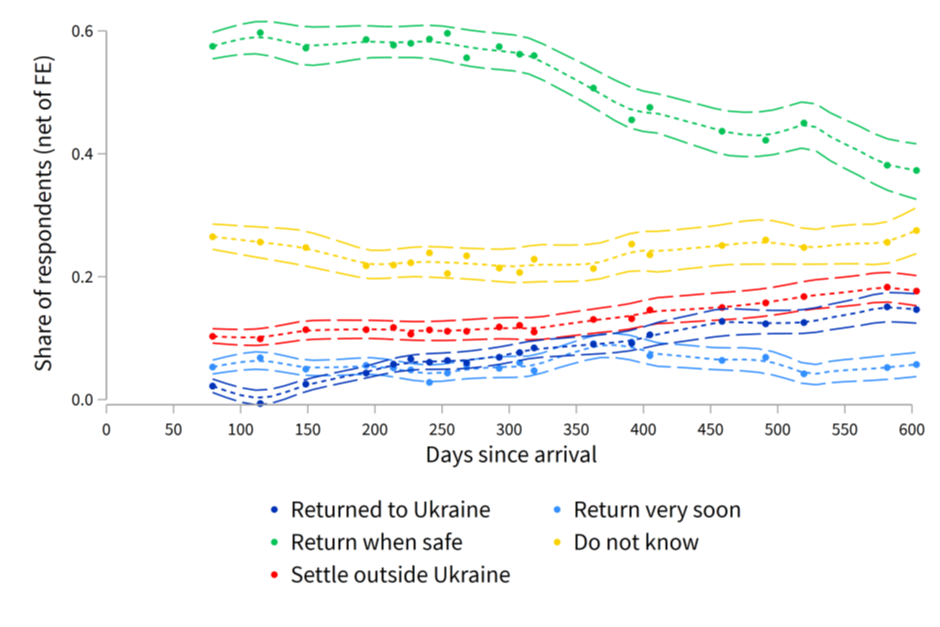Russia’s full-scale invasion of Ukraine on February 24, 2022, triggered the largest refugee crisis in Europe since World War II. Over 4 million Ukrainians currently reside in the European Union with temporary protection status. A new IZA Discussion Paper by Joop Adema, Cevat Giray Aksoy, Yvonne Giesing, and Panu Poutvaara examines their return plans, actual return experiences, and integration outcomes during the war.
Unique panel survey of refugees
In June 2022, the authors partnered with the survey company Verian (formerly Kantar Public) to launch a Europe-wide survey of Ukrainian refugees. Respondents are repeatedly asked about their current location, return plans, and integration experiences. These answers are linked to geocoded data on conflict intensity in their home municipalities. This approach allows the researchers to estimate the causal effect of local conflict on actual return, return plans, and integration outcomes.
Most Ukrainians plan to return home
In the first wave of the survey conducted in 2022, roughly two-thirds of Ukrainian refugees expressed an intention to return either soon or when conditions became safe. Only one in ten planned to settle permanently abroad. Return plans strongly predicted actual return: one-third of those who initially intended to return soon had done so by the follow-up interview. Conversely, none of those who planned to settle permanently outside Ukraine had returned. This is calculated over the average period of 268 days between the first and last interviews. The following figure illustrates the change in return intentions and actual return rates of participants over time since arriving in host countries. The average return rate to Ukraine is 2.7 percentage points per 100 days. The average net increase in planning to settle outside Ukraine is 1.6 percentage points per 100 days.
Liberation of home district increases return
Approximately 8 percent of respondents originated from districts liberated by Ukraine between their initial and follow-up interviews. Liberation of the home district increased the probability of returning to Ukraine by 5 percentage points.
Local fighting reduces return to hometown but not overall return
A higher intensity of local conflict in the home municipality reduces the likelihood of returning there specifically, but not to Ukraine overall. However, it does slightly increase the probability of starting to plan for permanent settlement outside Ukraine.
The effect of war expectations
Ukrainians’ war expectations have become more pessimistic over time. Between September 2022 and January 2023, 71 percent of participants expected the war to end with Ukraine liberating all occupied territories by the end of 2024. This share dropped to 36 percent by October-November 2023. Notably, the proportion of respondents who have either returned to Ukraine or plan to do so has decreased considerably less, from 66 percent to 54 percent. At the individual level, more pessimistic war expectations predict a 5 percentage point higher probability of starting to plan to settle outside Ukraine.
Integration outcomes
Local conflict intensity, liberation of the home district, and more pessimistic war expectations do not have a statistically significant effect on the likelihood of working in the host country. Liberation of the home district slightly reduces the probability of being in training, which aligns with the idea that higher return intentions decrease investment in host-country specific training.
Implications
The success of post-war reconstruction and development efforts in Ukraine will critically depend on the quantity and quality of available human capital. The Ukrainian population had already been declining even before the Russian invasion. Furthermore, widespread corruption and low confidence in the judiciary – underscored by Ukraine’s ranking of 104th out of 180 countries in the 2023 Corruption Perceptions Index – act as deterrents to return migration. A critical challenge for Ukraine will be to leverage the sense of national unity fostered by the war to drive broader institutional and cultural reforms. By addressing these challenges, Ukraine can enhance the appeal of returning for refugees and effectively utilize their human capital in the post-war rebuilding process.

